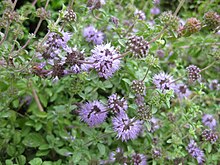Pulegon
| Structural formula | ||||||||||||||||
|---|---|---|---|---|---|---|---|---|---|---|---|---|---|---|---|---|

|
||||||||||||||||
| General | ||||||||||||||||
| Surname | Pulegon | |||||||||||||||
| other names |
|
|||||||||||||||
| Molecular formula | C 10 H 16 O | |||||||||||||||
| Brief description |
yellowish liquid with an intense odor |
|||||||||||||||
| External identifiers / databases | ||||||||||||||||
|
||||||||||||||||
| properties | ||||||||||||||||
| Molar mass | 152.23 g mol −1 | |||||||||||||||
| Physical state |
liquid |
|||||||||||||||
| density |
0.94 g cm −3 |
|||||||||||||||
| boiling point |
224 ° C |
|||||||||||||||
| solubility |
|
|||||||||||||||
| safety instructions | ||||||||||||||||
|
||||||||||||||||
| As far as possible and customary, SI units are used. Unless otherwise noted, the data given apply to standard conditions . | ||||||||||||||||
Pulegon is a monocyclic monoterpene ketone with a pleasant odor reminiscent of peppermint and camphor . The specific rotation is [α] D + 22.5 °.
Occurrence
Pulegon is found in all parts of the Polei mint ( Mentha pulegium ) plant and also in Hedeoma pulegioides .
effect
Pulegon is harmful to health. It irritates the digestive tract , but also the intact skin and mucous membranes . Pulegon can cause cramps, acidosis, and colic .
use
Pulegon is used as a raw material for the production of perfume oils for soaps and detergents, as a component of insect repellants and for the synthesis of menthol .


